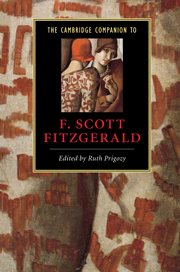Book contents
- Frontmatter
- 1 Introduction: Scott, Zelda, and the culture of celebrity
- 2 F. Scott Fitzgerald, age consciousness, and the rise of American youth culture
- 3 The question of vocation in This Side of Paradise and The Beautiful and Damned
- 4 The short stories of F. Scott Fitzgerald
- 5 The Great Gatsby and the twenties
- 6 Tender is the Night and American history
- 7 Fitzgerald’s expatriate years and the European stories
- 8 Women in Fitzgerald’s fiction
- 9 Fitzgerald’s nonfiction
- 10 Fitzgerald and Hollywood
- 11 The critical reputation of F. Scott Fitzgerald
- Bibliography
- Index
9 - Fitzgerald’s nonfiction
Published online by Cambridge University Press: 28 May 2006
- Frontmatter
- 1 Introduction: Scott, Zelda, and the culture of celebrity
- 2 F. Scott Fitzgerald, age consciousness, and the rise of American youth culture
- 3 The question of vocation in This Side of Paradise and The Beautiful and Damned
- 4 The short stories of F. Scott Fitzgerald
- 5 The Great Gatsby and the twenties
- 6 Tender is the Night and American history
- 7 Fitzgerald’s expatriate years and the European stories
- 8 Women in Fitzgerald’s fiction
- 9 Fitzgerald’s nonfiction
- 10 Fitzgerald and Hollywood
- 11 The critical reputation of F. Scott Fitzgerald
- Bibliography
- Index
Summary
F. Scott Fitzgerald will be remembered primarily for his novels and stories, but during his twenty years as a professional writer, he also produced an important and revealing body of work in the form of articles and essays and correspondence. The very best of these - the autobiographical pieces written in the 1930s - command the lyrical magic and emotional power of his most lasting fiction. And even at their least meritorious, in the advertisements for himself Fitzgerald composed as a beginning author, these articles reveal a great deal about the way he wanted to present himself to his readers. Read chronologically, they trace the rise and fall of his career from the publication of This Side of Paradise in March 1920 to his final years in Hollywood.
In accepting This Side of Paradise for publication, editor Maxwell Perkins at Scribners asked Fitzgerald for a photograph and some publicity material. “You have been in the advertising game long enough to know the sort of thing,” Perkins added (Dear Scott/Dear Max, 21). In fact, Fitzgerald had worked only four months for the Barron Collier agency in New York, from March to July 1919, but he did understand how promotion could help sell books and was eager to cooperate in the enterprise. In a letter presented at the American Booksellers' Convention and included on a leaf added to several hundred copies of the novel, he began to establish a public personality designed at once to shock and attract his audience.
- Type
- Chapter
- Information
- The Cambridge Companion to F. Scott Fitzgerald , pp. 164 - 188Publisher: Cambridge University PressPrint publication year: 2001
- 1
- Cited by



